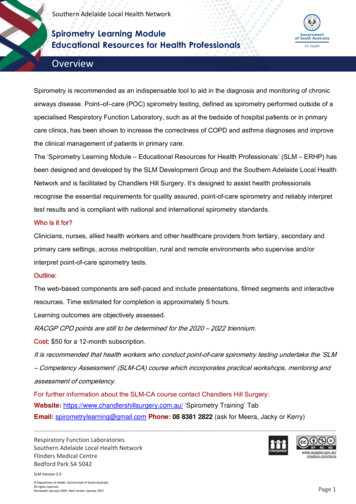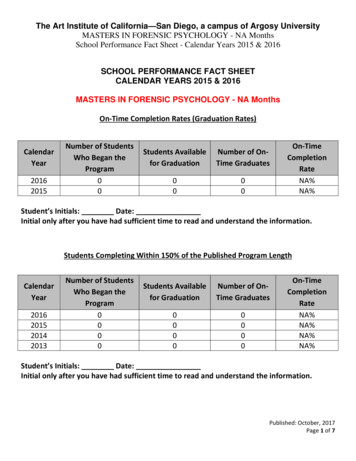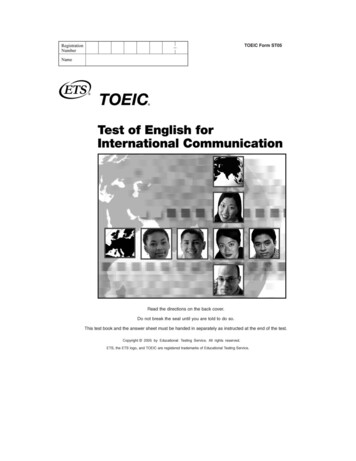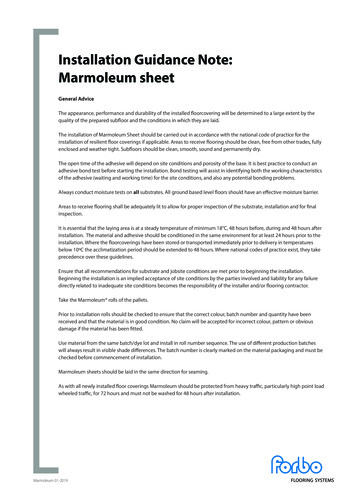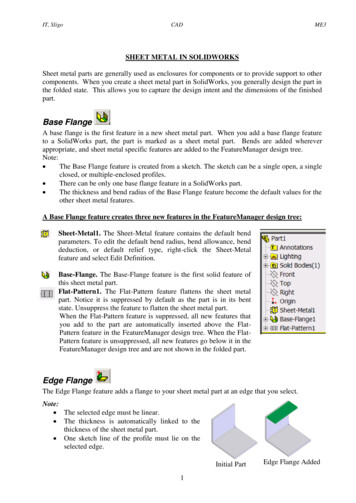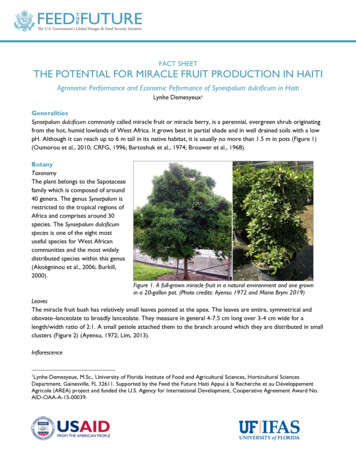
Transcription
FACT SHEETTHE POTENTIAL FOR MIRACLE FRUIT PRODUCTION IN HAITIAgronomic Performance and Economic Peformance of Synespalum dulcificum in HaitiLynhe Demesyeux1GeneralitiesSynsepalum dulcificum commonly called miracle fruit or miracle berry, is a perennial, evergreen shrub originatingfrom the hot, humid lowlands of West Africa. It grows best in partial shade and in well drained soils with a lowpH. Although it can reach up to 6 m tall in its native habitat, it is usually no more than 1.5 m in pots (Figure 1)(Oumorou et al., 2010; CRFG, 1996; Bartoshuk et al., 1974; Brouwer et al., 1968).BotanyTaxonomyThe plant belongs to the Sapotaceaefamily which is composed of around40 genera. The genus Synsepalum isrestricted to the tropical regions ofAfrica and comprises around 30species. The Synsepalum dulcificumspecies is one of the eight mostuseful species for West Africancommunities and the most widelydistributed species within this genus(Akoègninou et al., 2006; Burkill,2000).Figure 1. A full-grown miracle fruit in a natural environment and one grownin a 20-gallon pot. (Photo credits: Ayensu 1972 and Maria Brym 2019)LeavesThe miracle fruit bush has relatively small leaves pointed at the apex. The leaves are entire, symmetrical andobovate–lanceolate to broadly lanceolate. They measure in general 4-7.5 cm long over 3-4 cm wide for alength/width ratio of 2:1. A small petiole attached them to the branch around which they are distributed in smallclusters (Figure 2) (Ayensu, 1972; Lim, 2013).Inflorescence1Lynhe Demesyeux, M.Sc., University of Florida Institute of Food and Agricultural Sciences, Horticultural SciencesDepartment, Gainesville, FL 32611. Supported by the Feed the Future Haiti Appui à la Recherche et au DéveloppementAgricole (AREA) project and funded the U.S. Agency for International Development, Cooperative Agreement Award No.AID-OAA-A-15-00039.
The flowers are white, small and can be in solitary or in small clusters. Miracle fruit flowers are composed by 4to 5 sepals and 4 to 5 petals. The reproductive parts are composed of 5 stamens and a single ovary with asimple style and an inconspicuous stigma. They are hermaphroditic and autogamous (Ayensu, 1972; Lim, 2013).Although cross pollination is possible, a more in-depth understandings of the pollination mechanisms is stillneeded to confirm the hypothesis (Figure 3).Figure 2. Leaves shape from two different types of Synsepalum dulcificum. (Photo credit: Maria Brym, 2019)Figure 3. Inflorescence and fruit of the miracle berry. From left to right: flower cluster of miracle fruit; matured fruits in thebush; harvested miracle fruit and peeled miracle fruit. (Photo credit: Demesyeux, L. & Brym M., 2019)FruitsMultiple times a year, the plant flowers and produces a small ellipsoid berry of approximately 2 cm long and 1cm wide that turns from green to red at maturity. Some types reportedly bear yellow fruits (Ayensu, 1972; Lim,2013). The fruit contains a seed that is surrounded by a thin layer of white pulp that has a mild cherry-like taste.This pulp contains a non-caloric, natural sweetener glycoprotein, called miraculin and this is the primary purposefor miracle fruit cultivation (Figure 3) (Inglett and Chen, 2011).UtilizationIn its center of origin, the plant has been exploited by the indigenous people for centuries in their diet as well asfor its medicinal properties (Burkill, 2000). The leaves, bark and roots are used in the treatment of diabetes,enuresis, kidney diseases and other afflictions. The fruit is a rich source of vitamin C, leucine, flavonols andanthocyanin (Du et al., 2014).2
The fruits also render sour foods and drinks more palatable changing a sour taste into sweet taste (Burkill,2000). The sensory impact is more similar to sugar than other natural, non-caloric sweeteners. This change intaste is triggered by a glycoprotein called miraculin, which is not sweet itself (Brouwer et al., 1968). Theproduction of miraculin in the fruit starts at the color break, around 6 weeks after pollination (Sun et al., 2007).The native state of miraculin is a dimer (40-48 kD) while its denatured state a monomer. The taste-modifyingactivity of the protein occurs at an acidic pH, with a maximum activity at pH 3.0 and lowest at neutral pH. Themonomeric form of miraculin itself has no activity at all pHs, and the dimerization of the monomeric form isrequired in order to trigger the taste altering property of the miraculin (Ito et al., 2007).The sweetening impact of miraculin can last more than 1 hour after being held in the mouth for approximately 3minutes. It can trigger sweetness from a large range of acids such as HCl, lactic acid, formic acid, oxalic acid,acetic acid and citric acid (Kurihara and Beidler, 1969).Taste-Altering MechanismThe mechanism of the taste altering property of the miraculin has been studied by several investigators.According to Kurihara and Beidler (1969) sweetness is induced when the miraculin molecule binds to the tastereceptors and activates the sweet receptors at low pH. Koizumi et al. (2011) confirmed that miraculin activateshT1R2-hT1R3 which is the human sweet taste receptor at low pH, suggesting the same mechanism previouslydescribed by Kurihara and Beidler in 1969.PropagationMiracle fruit can be propagated by seeds as well as by vegetative means, including micropropagation. Althoughpropagation through cuttings is the fastest way to reach the reproduction phase, it has been observed that it isthe most challenging way to reproduce miracle fruit due to the complications encountered when it comes tostimulate healthy roots from the cutting (Joyner, 2006). In parallel, Chen (2012) and Ogunsola an Ilori (2008)have found some success reproducing miracle fruit through micropropagation method by using indole butyricacid in the first study and a specialized medium (Murashing-Skoog) with a combination of chemicals for thesecond one to stimulate shoot proliferation and the rooting process. Thus, reproduction by seed seems to bethe best reproduction technique for this crop since it offers faster growth and preserve their genetic variation(Achigan-Dako, et al., 2015).When it comes to seed propagation, post-harvest length prior planting, seed coat, and incubation temperatureplay an important role in seed germination although more studies on these factors would bring more certaintyon our current knowledge. Nevertheless, in a study conducted in 2018 by Chambers, et al., a maximum of 63%of the seeds without seed coats, at 0 drying days and incubated at 30 C germinated after the 10 days that lastedthe experiment, while only 20% of those seeds germinated when they increased the drying days to 2 days afterharvest. Of all these factors, the seed coat seems to be the most significant factor considering that only a fewseeds with their intact seed coat germinated at 30 C during the 10 days of incubation period. The same studydemonstrated that miracle fruit seeds can germinate and produce decent roots and shoot at 23 C too, but theroot growth is inhibited at 37 C (Chambers, et al., 2018).Moreover, seed moisture and storage temperature play an important role as they affect the viability of theseeds. For example, a study showed that the viability of seeds is nearly 100% when they are fresh with 36.6% ofwater content. However, when the seeds lose their water content to 20% due to a prolonged utilization after3
harvest, a total loss of viability was recorded. The same detrimental result was found when the seeds wherestored at 0 C while storage at 25 C help maintain the seeds shelf life for 28 days but with a very lowgermination rate (Tchokponhoué et al., 2019).Another important factor to consider when it comes to sexual reproduction of miracle fruit is surfacesterilization of the seeds as they are prone to microbial contamination. As a first step to germinate miracle fruitseeds, it is important to clean the pulp out of the seeds prior removing the seed coats to facilitate better andfaster germination. Chambers, et al., evaluated in 2018 the effects of various surface sterilization treatments onmiracle fruit seeds germination including water control, 10% bleach, 3% H2O2, and 2% NaDCC. The germinationrate was higher for the sterilization with water (53%) followed by 47% for the 10% bleach and 43% for the 3%H2O2, although the microbial growth was only 3% for the 3% H2O2 while it was 13% for the treatment with plainwater and 30% with the 10% bleach (Chambers, et al., 2018).In conclusion, as demonstrated by past studies, sexual reproduction of miracle fruit offers many advantages overvegetative reproduction considering that it is possible to obtain healthier and more vigorous seedlings fromthem, however with the vegetative reproduction, the reproduction phase is reached so much faster.Additionally, the key to obtain higher rate of germination is to remove the seed coats and to incubate thesterilized seeds at 30 C as soon as possible after harvest as the germination rate decreases each day afterharvest.Growth and developmentAs reported by previous studies, miracle fruit is a very slow-growing species that takes about 3 to 4 years toreach its reproductive phase (Joyner, 2006). The vegetative phase appears to be the longest phase where incertain cases, the plant reach only 50 cm tall (Achigan-Dako, et al., 2015). During the second phase, the plantbecomes mature, grows faster and can reach up to 5 meters tall in home gardens or when integrated inagroforestry systems as reported in Benin (Oumorou et al., 2010). However, new interests in the plant haveincentivize researchers in finding alternatives to reduce the length of this phase. For instance, it has beendemonstrated that a daily water input and application of inorganic nutrients (NPK) at a dose of 1.5 g for eachelement positively affected the vegetative and reproductive phase of seedlings of 15 months old. While thewater treatment alone (2l daily on each seedlings) appears to be the most important factor that triggers thetransition from the vegetative phase to the reproductive phase at only 23 months old, the nutrientsapplications were more beneficial to the productivity of the species (longer production period and more intensefruiting) (Tchokponhoué et al., 2017). Another group of authors were successful in reducing the vegetativephase to only 24 months too by reducing the light exposure to the plants and applying organic fertilizers to theseedlings (Tchokponhoué et al., 2019).Cultural practicesMiracle fruit is a new crop, only recently it has gained the attention of the scientific world as a crop due to itspromising future in the food, pharmaceutical and cosmetic industries. Data on the cultural practices (Weedmanagement, pest control, fertilization and other practices) are still to be investigated. Apart from few studiesthat investigated its botany, the effect of shade, water application and fertilization on miracle fruit, agronomicinformation on this crop is still very limited and more studies need to be done in other to have a broader ideaon how to effectively produce it at a larger scale.4
Production and potential yieldIn terms of production and yield performance, information on large-scale production of this crop is scarce.Originally, knowledge about its yield potential was based on information reported for individual stands found inhome gardens or farms. Such stands were reported to produce between 12-15kg/year/tree (Achigan-Dako et al.,2015), though, the information regarding the plant materials (age, type, growing environments) and the methodused to collect these data were missing.In order to advance our foundational understanding of the commercial potential for selected morphotypesdeveloped in the USA, a study was conducted with 9 different miracle fruit types for a yearlong period. Data wascollected weekly, over 52 weeks on 66 mature trees to capture the yield performance of this crop. The resultsrevealed that each tree had the potential to produce in average 2.1 kg of fruit per year. The most performanttype under the conditions of the study produced in average 2.76 kg/tree/year which is 5 times lower than theyield reported above (Demesyeux et al., 2020). But since the data reported by Achigan-Dako (12-15kg/tree/year) was not obtain through vigorous statistics, it cannot be used as a good reference for this crop.During this experiment, 6 different peaks of production were identified across the 52 weeks that lasted thestudy (Figure 4). Each of these peaks were recorded approximately every 2 months of the experiment whichcreated what can be called “harvest windows for this crop. The total fruit (46.6kg) harvested during the firstharvest window (May 21- July 12) was significantly the highest yield recorded, compared to the 11.67 kg and15.90 obtained for harvest window 3 (September 10- November 13) and 2 (July 16- September 4) respectively(Figure 5) (Demesyeux et al., 2020).These data confirmed that multiple harvest can be obtained from miracle fruit throughout the year and can be avaluable asset for current and future producers of this crop in the planning of their operational and marketingactivities.Figure 4. Total fruit yield in kg from miracle fruit for the six harvest peaks were recorded (Demesyeux et al., 2020).Average Fruit Weight and DimensionEach miracle fruit berry weighs in average 1.39g with a range of 0.13 to 2.96 g /fruit. This study also identifiedImperial’, ‘Cherry’, ‘Scarlet’, and ‘Vermilion’ as the morphotypes with the heaviest fruits. As for the fruitsdimensions, the average fruit length was 1.99 cm while the average width was 1.18 cm. Of the nine morphotypesevaluated, ‘Holly’ and ‘Cardinal’ had the biggest fruits in terms of length and width compared to the other types(Demesyeux et al., 2020).5
Potential uses of miraculinOver the past four decades, the consumption of sugar has increased considerably among children and adults inthe US. This is correlated with a growing number of people affected by chronic diseases such as obesity,diabetes type II, cardiovascular disorders and fatty liver disease (Ogden et al., 2015). This has led to the popularadoption of alternative sweeteners, many of them artificial. Unfortunately, some of these alternative sweetenercompounds have negative sensory impacts or are now suspected to have negative impacts on human health(Suez et al., 2014). Thus, the demand for natural, non-caloric sweeteners such as miraculin is predicted toincrease over the coming years.Figure 5. Yield performance of miracle fruit by harvest windows. Total and average yield are shown for all 66 trees(Demesyeux et al., 2020).Current medical applicationsThis crop has also been studied extensively in the medical field. For example, its utilization has shown positiveresults in helping to treat diabetic patients with insulin resistance (Chen et al., 2006). Moreover, testimonies ofboth medical doctors and cancer patients suggest that the ingestion of miraculin improves chemotherapyassociated taste changes, thus, improving nutrition and quality of life of these patients. It has been approved byBaptist Health South Florida Hospital as the first and only dietary supplement to be distributed in their hospitalnetwork. (Wilken and Satiroff, 2012; Miracle Fruit Farm, 2019).Economic importance and potential for production in HaitiMiracle fruit, as the unique natural source of miraculin is gaining a lot of interest nowadays because of itspromising economic potential to serve as an alternative to synthetic sugar and as a dietetic supplement fordiabetic patients (Wong & Kern, 2011). Its taste altering property is being evaluated and trialed as a naturalflavor enhancement to help cancer patients that went through radiation or chemotherapy to regain theirpalatability. Although utilized also in the food and cosmetic industry, miracle fruit is mostly valued in thepharmaceutical industry (Achigan-Dako et al., 2015). This crop is being sold, mainly virtually on many forms(Plants, fresh fruits, powder, dry fruits coated with miracle fruit powder and flavor enhancement tablets) atextensive prices. For instance, fresh fruits are sold in small bags containing 30 fruits for approximately USD30,while a kg of powder can reach up to USD2500 (https://www.miraclefruitfarm.com/shop).This crop offers a great opportunity to diversify income sources and to empower smallholder farmers indeveloping countries such as Haiti (Fandohan et al., 2017). Due to its tropical climate and rich soils, manyregions in Haiti are suitable for the crop’s production. Since information regarding the optimal temperatureranges for the growth and reproduction of this crop is missing, it would be recommended to concentrate the6
production in hot and humid lowlands as suggested by Milhet and Costes 1984. Moreover, considering that itgrows better under partial shade, integrating miracle fruit in agroforestry systems with other tropical fruits suchas mango and avocado as suggested by (Oumorou et al., 2010), could help diversify income sources in thehousehold and contribute to soil conservation as a perennial crop.Miracle fruit could help alleviate poverty in the country as well as stated by Achigan-Dako, 2015. At the currentprice this fruit is being sold online ( 1 /berry) and its average yield, a farmer can hope to earn more than1000 /tree/year with the proper marketing. Additionally, producing the crop in country, would increase itsavailability for the population and help improving the life of the increasing number of diabetic and cancerpatients.ConclusionSynsepalum dulcificum is a tropical crop with great potential. It can offer many benefits to the world population interms of its medicinal properties. However, there is a pressing need to expand our knowledge on itshorticultural and environmental requirements for a better exploitation of its properties. This crop could serveas an alternative income source for our farmers and could represent an opportunity to educate Haiti’spopulation, especially those affected by chronic diseases such as diabetes on alternative natural sweetener toinclude in their diet to promote a healthier lifestyle.References1) Akoègninou, A., Van der Burg, W. J., & Van der Maesen, L. J. G. (2006). Flore analytique du Bénin (No.06.2). Backhuys Publishers.2) Achigan-Dako, E. G., Tchokponhoué, D. A., N’Danikou, S., Gebauer, J., & Vodouhè, R. S. (2015).Current knowledge and breeding perspectives for the miracle plant Synsepalum dulcificum (Schum. etThonn.) Daniell. Genetic resources and crop evolution, 62(3), 465-476.3) Ayensu, E. S. (1972). Morphology and anatomy of Synsepalum dulcificum (Sapotaceae). Botanical Journal ofthe Linnean Society, 65(2), 179-187.4) Bartoshuk, L. M., Gentile, R. L., Moskowitz, H. R., & Meiselman, H. L. (1974). Sweet taste induced bymiracle fruit (Synsepalum dulcificum). Physiology & behavior, 12(3), 449-456.5) Brouwer, J. N., Van Der Wel, H., Francke, A., & Henning, G. J. (1968). Miraculin, the sweetness-inducingprotein from miracle fruit. Nature, 220(5165), 373.6) Burkill, H. M. (1985). The useful plants of West Africa. Royal Botanical Gardens, Kew, 1.7) Burkill, H. M. (2000). Families SZ. In The useful plants of West Tropical Africa (Vol. 5, p. 686). Addenda.Royal Botanic Gardens Kew.8) California Rare Fruit Growers Inc (CRFG). 1996. Miracle fruit, Synsepalum it.html.9) Chambers, A., Demesyeux, L., Moon, P., & Fu, Y. (2018). Optimization of miracle fruit (Synsepalumdulcificum) seed germination and mutagenesis.10) Chen, C. C., Liu, I. M., & Cheng, J. T. (2006). Improvement of insulin resistance by miracle fruit(Synsepalum dulcificum) in fructose-rich chow-fed rats. Phytotherapy Research: An International JournalDevoted to Pharmacological and Toxicological Evaluation of Natural Product Derivatives, 20(11), 987-992.11) Chen XW, Abdullah TL, Abdullah NAP, Hassan SA (2012). Rooting response of miracle fruit(Synsepalum dulcificum) softwood cuttings affected by indole buriatic acid. Am J Agric Biol Sci 7:442-4467
12) Demesyeux, L., Brym, M., Valdes, D., Collazo, C., & Chambers, A. H. (2020). Yield and miraculin contentof nine miracle fruit (Synsepalum Dulcificum) morphotypes. Euphytica, 216(11), 1-12.13) Fandohan, A. B., Gouwakinnou, G. N., Tovissode, C. F., Bonou, A., Djonlonkou, S. F. B., Houndelo, L. F.,. & Assogbadjo, A. E. (2017). Usages traditionnels et valeur économique de Synsepalum dulcificum auSud-Bénin. BOIS & FORETS DES TROPIQUES, 332, 17-30.14) Inglett, G. E., and May, J. F. 1968. Tropical plants with unusual taste properties. Economic Botany, 22(4),326-331.15) Inglett, G. E., Dowling, B., Albrecht, J. J., & Hoglan, F. A. (1965). Taste modifiers, taste-modifyingproperties of miracle fruit (Synsepalum dulcificum). Journal of Agricultural and Food Chemistry, 13(3), 284287.16) Ito, K., Asakura, T., Morita, Y., Nakajima, K. I., Koizumi, A., Shimizu-Ibuka, A., & Kitamoto, K. (2007).Microbial production of sensory-active miraculin. Biochemical and biophysical research communications,360(2), 407-411.17) Joyner G (2006) The miracle fruit. In: Scott P (ed) Quandong magazine of the west Australian nutand tree crop asso-ciation. West Australian Nut and Tree Crop Association Subiaco, WestAustralia, p 15.18) Koizumi, A., Tsuchiya, A., Nakajima, K. I., Ito, K., Terada, T., Shimizu-Ibuka, A., . & Abe, K. (2011).Human sweet taste receptor mediates acid-induced sweetness of miraculin. Proceedings of the NationalAcademy of Sciences, 108(40), 16819-16824.19) Kurihara, K., & Beidler, L. M. (1968). Taste-modifying protein from miracle fruit. Science, 161(3847),1241-1243.20) Kurihara, K., & Beidler, L. M. (1969). Mechanism of the action of taste-modifying protein. Nature,222(5199), 1176.21) Kurihara, Y. (1992). Characteristics of antisweat substances, sweet proteins, and sweetness-inducingproteins. Critical Reviews in Food Science & Nutrition, 32(3), 231-252.22) Lim, T. K. (2013). Synsepalum dulcificum. In Edible medicinal and non-medicinal plants (pp. 146-150).Springer, Dordrecht.23) Miracle fruit farm. (2019). Retrieved from: http://www.miraclefruitfarm.com/#.24) Ogden, C. L., Carroll, M. D., Fryar, C. D., & Flegal, K. M. (2015). Prevalence of obesity among adults andyouth: United States, 2011–2014.25) Ogunsola KE, Ilori CO (2008) In vitro propagation of miracle berry (Synsepalum dulcificum Daniell)through embryo and nodal cultures. Afr J Biotechnol 7:244-248.26) Oumorou, M., Dah-Dovonon, J., Aboh, B. A., Hounsou Kaka, M., & Sinsin, B. (2010). Contribution à laconservation de Synsepalum dulcificum: régénération et importance socioéconomique dans ledépartement de l’Ouémé (Bénin). INRA, LEA, EPAC.27) Suez, J., Korem, T., Zeevi, D., Zilberman-Schapira, G., Thaiss, C. A., Maza, O., & Kuperman, Y.(2014). Artificial sweeteners induce glucose intolerance by altering the gut microbiota. Nature,514(7521), 181.28) Sun HJ, Kataoka H, Yano M., & Ezura H (2007) Genetically stable expression of functional miraculin, anew type of alternative sweetener, in transgenic tomato plants. Plant biotechnology journal, 5(6) 768–777.29) Wilken, M.K., & Satiroff, B.A., (2012). Pilot study of "miracle fruit" to improve food palatability forpatients receiving chemotherapy. Clinical journal of oncology nursing, 16(5), E173.30) Wong, J. M., & Kern, M. (2011). Miracle fruit improves sweetness of a low-calorie dessert withoutpromoting subsequent energy compensation. Appetite, 56(1), 163-166.8
31) Xingwei, C., Abdullah, T. L., Taheri, S., Abdullah, N. A. P., & Hassan, S. A. (2016). Flower ontogenesisand fruit development of Synsepalum dulcificum. HortScience, 51(6), 697-702.32) Tchokponhoué, D. A., N’Danikou, S., & Achigan-Dako, E. G. (2019). A combination of approachesevidenced seed storage behaviour in the miracle berry Synsepalum dulcificum (Schumach. et Thonn.)Daniell. BMC plant biology, 19(1), 1-11.33) Tchokponhoué, D. A., N'Danikou, S., Hale, I., Van Deynze, A., & Achigan-Dako, E. G. (2017). Earlyfruiting in Synsepalum dulcificum (Schumach. & Thonn.) Daniell juveniles induced by water and inorganicnutrient management. F1000Research, 6.34) Tchokponhoué, Dèdéou A., Sognigbé N’Danikou, Jacob S. Houéto, and Enoch G. Achigan-Dako. "Shadeand nutrient-mediated phenotypic plasticity in the miracle plant Synsepalum dulcificum (Schumach. &Thonn.) Daniell." Scientific reports 9, no. 1 (2019): 1-11.9
Synsepalum dulcificum commonly called miracle fruit or miracle berry, is a perennial, evergreen shrub originating from the hot, humid lowlands of West Africa. It grows best in partial shade and in well drained soils with a low pH. Although it can reach up to 6 m tall in its native hab





